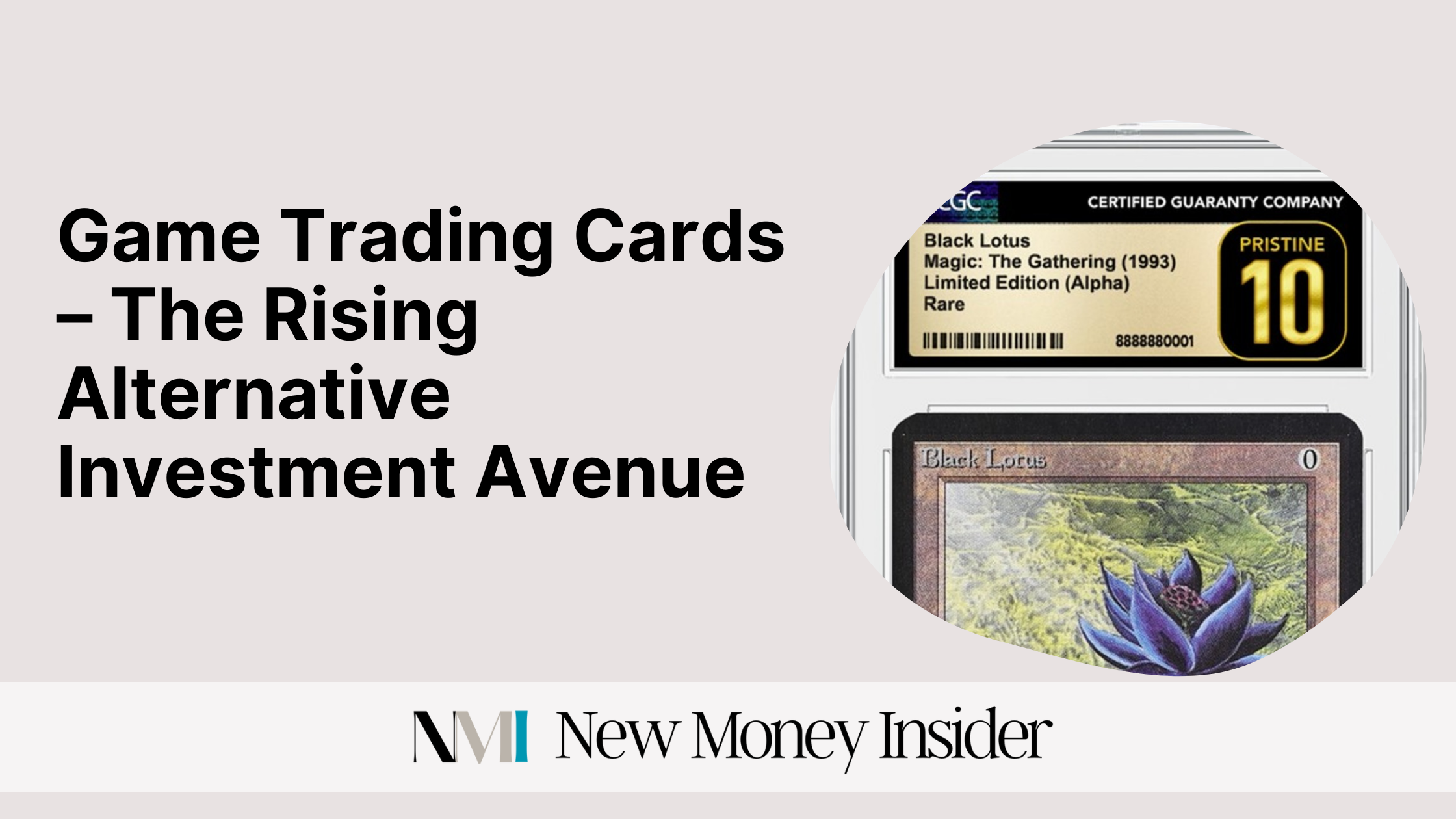
Source: NY Post
A rare 1999 Pokémon Charizard card fetched over $220,000 at auction in 2020.
It was in stark contrast to its original price of just a few dollars when it was first released.
This striking example shows the surge in value and popularity of game trading cards in recent years.
This sale also highlights the significant appreciation in value that some trading cards can achieve.
It also underscores the growing interest in this market among collectors and investors alike.
Key Takeaways
- High appreciation potential of game trading cards and how these collectibles can yield significant returns.
- Game trading cards transition from mere childhood hobbies to valuable collectibles and investment assets.
- The trading card market’s notable growth is driven by nostalgia, media exposure, and increasing recognition.
- Importance of professional grading that can help you enhance the value and marketability of your cards.
- Impact of cultural significance and nostalgia on card demand and value.
- Evaluating rarity and condition to identify high-potential cards for better investment returns.
- Staying informed about high-profile sales and media coverage to anticipate price fluctuations and to make strategic investment decisions.
Appeal Of Game Trading Cards
Game trading cards have emerged as an exciting alternative investment that blends nostalgia with potential financial gains.
Unlike traditional investments, such as stocks and bonds, trading cards offer a unique combination of cultural significance and rarity that appeals to a broad spectrum of enthusiasts and investors.
The market for these collectibles has expanded dramatically. This has been fueled by a blend of childhood nostalgia, the hunt for rare items, and the potential for substantial financial returns.
Historical Context and Evolution of Game Trading Cards

Source: Magic Wizards
The history of game trading cards dates back to the early 1990s, a period marked by the release of some of the most iconic trading card games that would go on to shape the industry.
Origins and Development
Have you heard of one of the earliest and most influential games "Magic: The Gathering?”
It was created by Richard Garfield and first published by Wizards of the Coast in 1993.
This game introduced the concept of a collectable card game (CCG), where players could build their decks from a pool of available cards, each with unique abilities and attributes.
The success of "Magic: The Gathering" not only popularized the CCG format but also paved the way for future trading card games.
On somewhat similar lines, in 1996, the Pokémon Trading Card Game (TCG) was launched by Nintendo, leveraging the immense popularity of the Pokémon franchise.
The Pokémon TCG quickly became a global phenomenon, with children and adults alike collecting, trading, and playing with the cards.
Its early sets like "Base Set," "Jungle," and "Fossil" are now highly sought after by collectors.
As these games gained popularity, trading cards transitioned from mere childhood hobbies to coveted collectables and, eventually, investment assets.
The rarity and condition of specific cards began to play a significant role in their value.
Limited print runs, special editions, and promotional cards started to fetch higher prices in secondary markets.
Collectors who once traded cards on playgrounds began to see their childhood treasures appreciate in value, creating a growing market for serious collectors and investors.
Market Growth
Over the past few years, the trading card market has experienced significant growth.
This has been driven by a combination of nostalgia, increased media exposure, and a growing recognition of trading cards as legitimate investment assets.
This growth has been marked by notable spikes in card values and high-profile sales.
Notable Sales

Source: Hobbylistings
One such example is the dramatic increase in the value of Magic: The Gathering's Black Lotus card.
Originally part of the Alpha set released in 1993, the Black Lotus is one of the most coveted cards due to its powerful game effects and limited availability.
This card was part of the Alpha set, the first set ever printed, and only 1,100 copies were made.
Its game-changing abilities, combined with its limited availability, have made it one of the most sought-after cards in the trading card community.
In 2019, a near-mint condition Black Lotus card sold for $166,100 at auction.
By January 2021, another copy of the same card in mint condition fetched an astounding $511,100 at an auction conducted by Heritage Auctions.
This significant appreciation highlights the growing demand for rare and valuable cards within the Magic: The Gathering community.
Similarly, first edition Pokémon cards, particularly the holographic ones, are highly prized.
For instance, a first-edition Charizard card in mint condition can fetch hundreds of thousands of dollars today.
These cards' limited print runs and the difficulty of finding them in pristine condition contribute to their high market value.
Gaming Cards Price Spikes and ROI
Several factors have contributed to these spikes in value.
The COVID-19 pandemic played a substantial role as people sought out nostalgic hobbies during lockdowns, leading to increased interest and spending on trading cards.
Investors also made good returns on their investments. This increased the interest in trading cards as an alternative investment.
What Influences Gaming Cards Price Surges?
The rise of social media platforms and influencers showcasing their card collections has often fueled the market, bringing in new collectors and investors.
High-profile auctions and record-breaking sales have also contributed to the perception of trading cards as viable investment opportunities.
Top Collectible Trading Cards companies
These are amongst the top collectible trading cards companies:
- The Pokémon Company
- Konami Holdings Corporation
- Panini
- Kayou
- Tokaratomy
- Wizards of the Coast
- Topps Company
- Bandai Namco
- Upper Deck Company
- Bushiroad
Niche Hobby To An Investment Avenue
The professional grading and authentication of cards by companies like PSA (Professional Sports Authenticator) and Beckett have added a layer of credibility and transparency to the market.
Graded cards, which are assessed for their condition and assigned a numerical grade, often command higher prices.
These also provide assurance to buyers regarding their investment's authenticity and quality.
Collectible Trading Cards ROI
As an investor, you may wonder, should you consider trading cards as a midterm or long-term investment?
To start with, this segment’s evolution from a niche hobby to a mainstream investment avenue has been nothing short of remarkable.
As trading cards continue to gain recognition as valuable assets, their market growth shows no signs of slowing down.
This makes a high-value alternative investment if you are looking to diversify your portfolio.
The popularity index of these cards is also growing as is shown by the various flash sales.
Here are a few examples of the substantial returns on trading cards for investors:
| Year | Company | Event/Statistic | Price/Percentage/Time | Rank in Sale |
|---|---|---|---|---|
| 2020 | Pokémon | Sales Increase | 574% | |
| 2020 | Pokémon | Total Cards Produced | 28 billion+ | |
| 2020 | Magic: The Gathering | Dominaria Set Sold Out | In 10 days | |
| 2020 | Vanguard Cardfight | Popularity Ranking | 5th | |
| 2020 | Dragon Ball Super | Top-Selling Card Game in North America | 4th | |
| 2021 | Magic: The Gathering | Black Lotus Card Sold | $511,000 | |
| 2020 | Magic: The Gathering | Secret Lair Set Sold Out | In 15 minutes | |
| 2018 | Yu-Gi-Oh! | Second Highest-Grossing Media Franchise | 2nd | |
| 2018 | Vanguard Cardfight | Sales Growth | 30% | |
| Pokémon | Countries Played In | 75+ | ||
| Yu-Gi-Oh! | Total Cards Sold Globally | 25 billion+ | ||
| Yu-Gi-Oh! | Guinness World Record: Top-Selling TCG | |||
| Hearthstone | Registered Players | 100 million+ | ||
| Hearthstone | Daily Players | 23.5 million |
Factors Driving the Investment Potential of Game Trading Cards
There are various factors that make game trading cards attractive as an alternative investment and affect their value or returns.
Some of these are:
Rarity and Scarcity
In the world of trading cards, not all cards are created equal. Print runs and limited editions play a crucial role in determining a card's value.
Print runs refer to the number of copies of a particular card that were produced.
Cards from early sets or those released in limited quantities often become more valuable over time due to their scarcity.
When you understand the rarity and scarcity of trading cards you can identify potentially valuable investments.
Knowing which cards were produced in limited numbers and tracking their availability in the market can provide you insights into their long-term investment potential.
Cultural Significance and Nostalgia
The cultural significance and nostalgia associated with game trading cards also drive their investment potential.
These cards often evoke powerful emotional connections, as many collectors associate them with cherished memories from their childhood.
This nostalgia fuels demand, as people are willing to pay a premium to reclaim a piece of their past.
Pop Culture, Media and Fan base
Before investing in trading cards, you must also do a thorough analysis of their value and potential returns.
Both Pop culture and media play significant roles in maintaining and increasing the value of these cards and consequently can impact the value of your investments.
Here are a few tips and examples you can follow:
- Pokémon has remained a cultural phenomenon for over two decades, continually renewing interest through new games, movies, and television series.
- The enduring popularity of Pokémon keeps the demand for its trading cards high.
- Magic: The Gathering, on the other hand, has built a dedicated fanbase since its inception.
- The game’s complex strategies and ongoing storyline keep players and collectors engaged.
- Cards from iconic sets or those associated with significant moments in the game’s history become more than just collectables; they are pieces of the culture.
- You need to tap into the emotional and cultural aspects of trading cards as a strategic move.
- Investing in cards from franchises with strong cultural significance can yield substantial returns, as these cards are likely to remain in demand.
- Keep an eye on trends in pop culture and media. This can also help you identify which cards might increase in value.
Condition and Grading
The condition of your trading cards is a critical factor in their value, and the grading process helps standardize this assessment.
Cards are graded based on their physical condition, including aspects such as centering, corners, edges, and surface.
Even minor imperfections can significantly affect your card's grade and, consequently its market value.
Professional grading companies like PSA (Professional Sports Authenticator) and Beckett provide grading services that assess and assign a grade to a card, typically on a scale from 1 to 10.
A higher grade indicates a card is in better condition. Cards graded as “gem mint” (usually a 10) are the most sought-after and command the highest prices.
Real-Life Example of Condition Affecting Pricing
The first edition Charizard card that is graded PSA 10.
If you have such a card, you can sell it for significantly more than the same card with a lower grade.
In recent years, a PSA 10 Charizard has sold for upwards of $300,000, while cards in lower conditions might sell for much less.
The credibility and assurance provided by professional grading companies help buyers and sellers agree on the card's value, making the market more transparent and trustworthy.
Understand the importance of card condition and grading to enhance your investment strategy.
Submit your cards for professional grading to increase their market value and make them more attractive to potential buyers.
Conversely, when you are purchasing cards, consider the grade to ensure you are making a sound investment.
Market Demand and Speculation On Gaming Cards

Source: Forgeandfiregaming
As an investor, you should be aware that the dynamics of market demand and speculation significantly influence the value of game trading cards.
Current trends and buyer behavior can also cause rapid fluctuations in card prices.
High-profile sales and media coverage often spark speculation, driving up prices.
For example, the sale of a PSA 10 Charizard for over $300,000 created a ripple effect in the market, with many collectors and investors rushing to buy and grade their cards in hopes of similar returns.
Premium on High-Grade Cards
Case studies of recent high-value sales highlight this phenomenon.
In 2020, a complete set of first edition Pokémon cards, all graded PSA 10, sold for over $100,000 at auction.
This sale showcased how complete, high-grade sets can command significant premiums.
Tips for Investing in Trading Cards
Here are a few tips you can follow for getting the best returns on trading cards:
- Stay informed about market trends and understand buyer behavior.
- Follow auction results, media reports, and social media influencers for insights into which cards are in demand.
- Use this knowledge to make informed investment decisions, whether you are buying, holding, or selling trading cards.
- Speculation can lead to high rewards, but it also requires careful analysis and a willingness to stay updated on market developments.
Conclusion
Game trading cards have undeniably emerged as a viable alternative investment, driven by factors such as rarity, cultural significance, condition, and market demand.
Game trading cards offer you a unique investment opportunity that combines passion with profit.
By tapping into the cultural significance and rarity of these collectables, you can potentially achieve significant financial gains.
However, like any investment, it’s important to proceed with caution, seek expert advice, and continuously educate yourself about market trends and valuations.
This approach will help you make informed decisions and capitalize on the exciting potential of game trading cards as an alternative investment avenue.
FAQs
1. Are game trading cards a good investment?
Yes, game trading cards can be a good investment due to their potential for significant value appreciation. However, this investment requires careful research, an understanding of market trends, and awareness of the risks involved.
2. How do I start investing in game trading cards?
You can start by researching popular card games like Pokémon and Magic: The Gathering, and familiarize yourself with rare and valuable cards. Purchase from reputable sources and consider getting cards professionally graded to ensure authenticity and condition.
3. What factors determine the value of a trading card?
The value of a trading card is determined by its rarity, condition, cultural significance, and current market demand. Professional grading can also significantly impact a card’s value.
4. How do I protect and store my trading cards?
Store your trading cards in protective sleeves and cases to prevent damage. Keep them in a cool, dry place away from direct sunlight, and consider using a secure storage box or safe for valuable cards.
5. What are the risks of investing in trading cards?
Investing in trading cards involves risks such as market volatility, potential for counterfeits, and liquidity issues. Prices can fluctuate, and it might be challenging to sell cards quickly at desired prices.
6. Should I get my trading cards professionally graded?
Yes, professional grading can enhance the value and marketability of your trading cards by providing a standardized assessment of their condition. Companies like PSA and Beckett are well-regarded in the industry for grading services.



